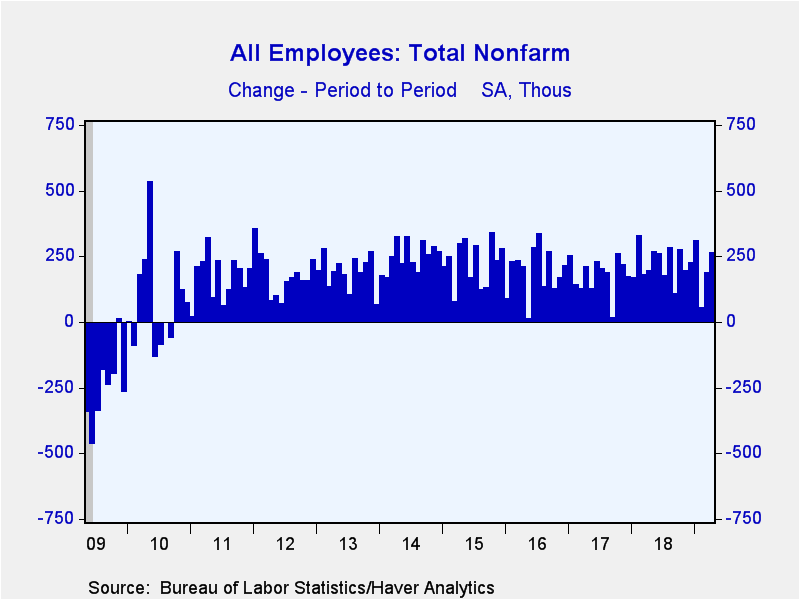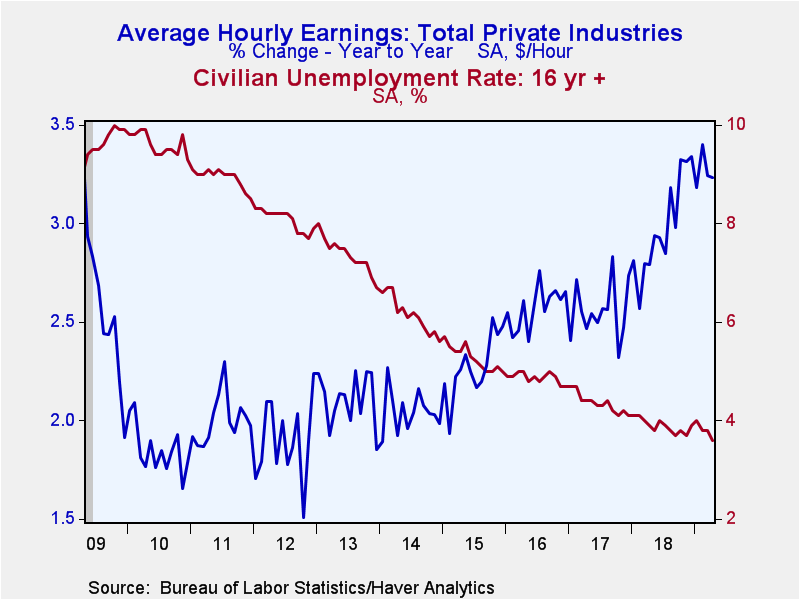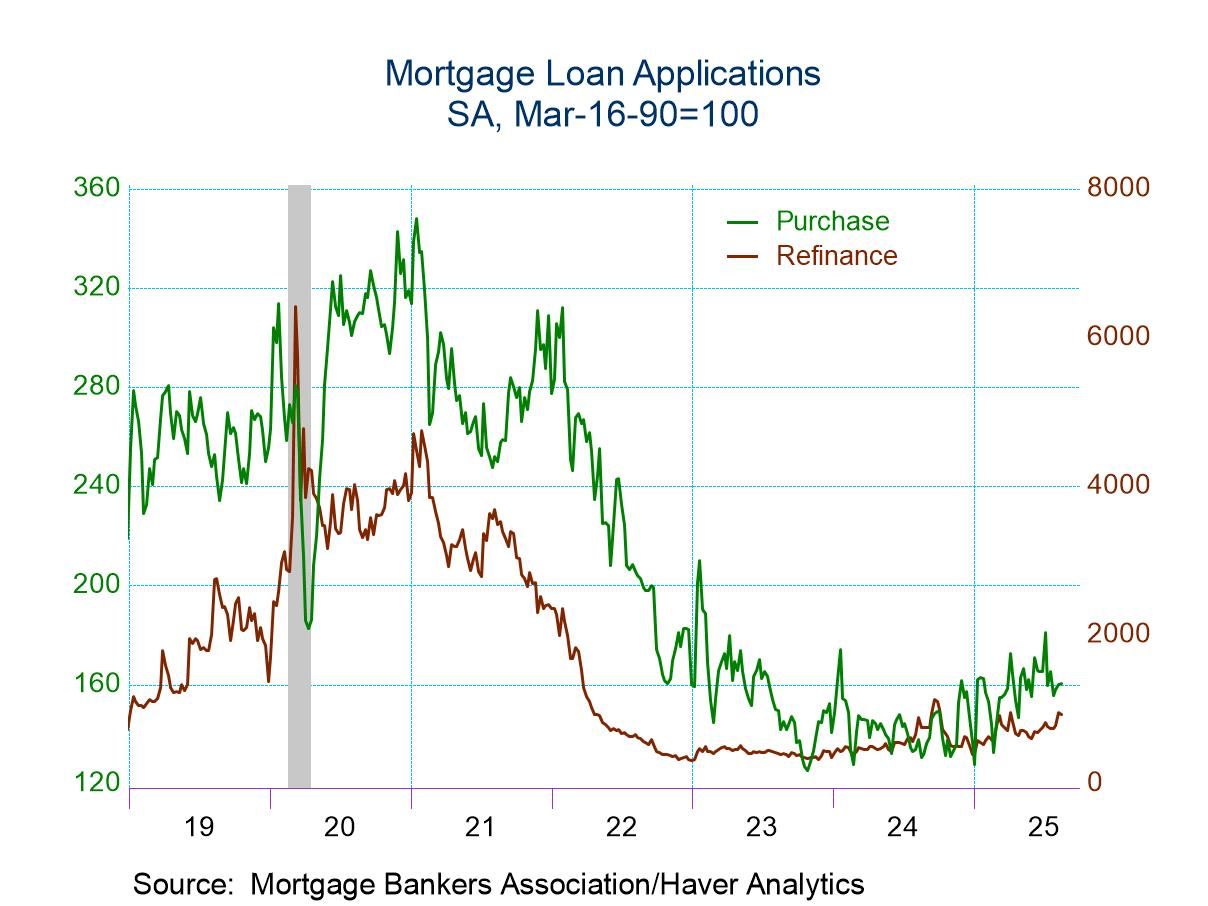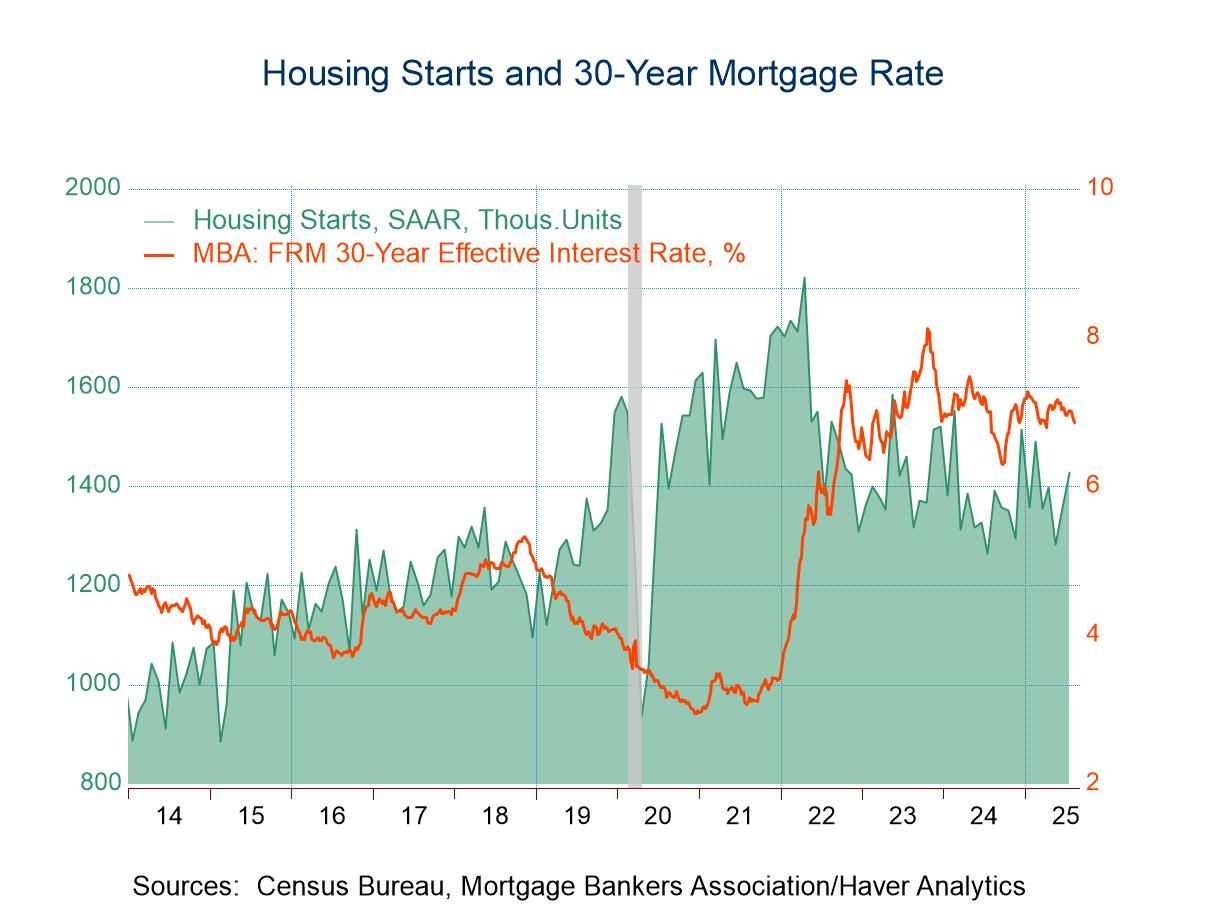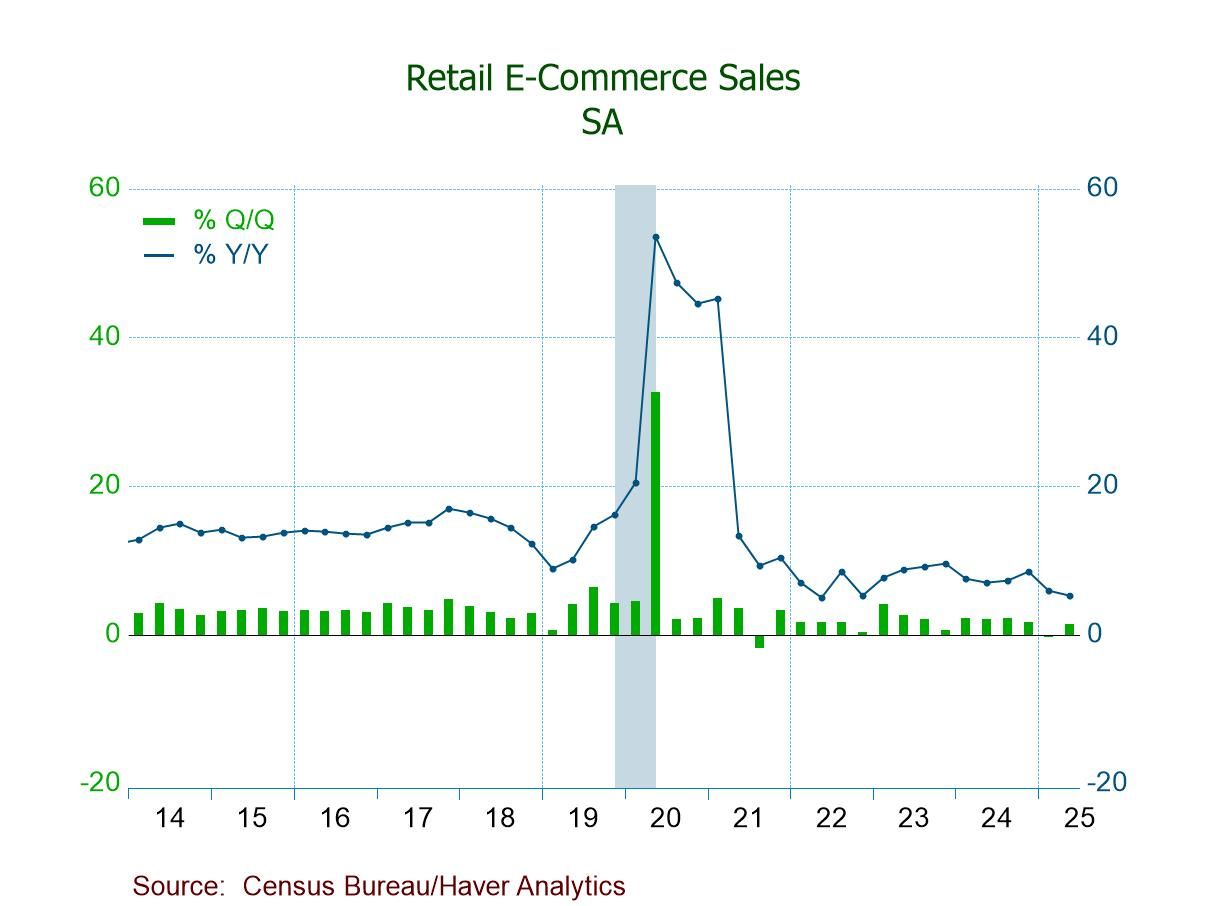 Global| May 03 2019
Global| May 03 2019U.S. Payroll Gains Are Unexpectedly Strong; Jobless Rate Falls to 1969 Low
by:Tom Moeller
|in:Economy in Brief
Summary
The labor market remained robust during April. Nonfarm payrolls increased 263,000 (1.8% y/y) following a 189,000 March gain, revised from 196,000. February's rise was revised higher to 56,000. The April increase exceeded expectations [...]
The labor market remained robust during April. Nonfarm payrolls increased 263,000 (1.8% y/y) following a 189,000 March gain, revised from 196,000. February's rise was revised higher to 56,000. The April increase exceeded expectations for a 185,000 rise in the Action Economics Forecast Survey. Average hourly earnings increased 0.2% (3.2% y/y) and missed expectations for a 0.3% rise. It followed a 0.2% March gain, revised from 0.1%.
The unemployment rate declined to 3.6% from 3.8% as the size of the labor force fell 490,000 m/m. It was the lowest rate since December 1969. The overall jobless rate, including those who were marginally attached or working part-time for economic reasons, was unchanged at 7.3%, the lowest level since March 2001.
From the payroll employment survey, the 263,000 increase in employment reflected a 33,000 increase in construction sector hiring (3.6% y/y) which built on a 20,000 March increase. Factory sector jobs improved 4,000 (1.6% y/y) following no change during March. Higher employment in nondurable goods industries accounted for all of the gain. Mining & logging sector employment fell 3,000 (+4.1% y/y) after 1,000 rise.
Employment in the private service sector increased 202,000 (1.9% y/y), the largest increase in three months. The gain was paced by a 76,000 rise (2.6% y/y) in professional & business services which was the largest monthly increase since December 2015. The strength also derived from a bolstered 17,900 rise (1.6% y/y) in temporary help jobs. Education & health services employment rose 62,000 (2.5% y/y), extending the strength of gains in five of the prior six months. Leisure & hospitality jobs improved 34,000 (2.8% y/y) after a diminished 37,000 gain. The number of financial activities jobs rose a improved 12,000 (1.3% y/y) while trade, transportation & utilities employment rose 5,000 (0.8% y/y). Information sector employment eased 1,000 (-0.6% y/y).
Government sector employment rose 27,000 (0.6% y/y). Federal government hiring rose 11,000 (0.6% y/y), a gain boosted by the hiring of temporary workers to begin the 2020 Census. State government employment declined 11,000 (+0.1% y/y). Local government employment rose 27,000 (0.7% y/y).
The 0.2% gain in average hourly earnings reflected a strengthened 1.1% surge (3.4% y/y) in mining sector earnings. Construction sector pay posted a 0.4% rise (3.1% y/y) while factory sector earnings inched 0.1% higher (1.9% y/y). Private service sector earnings rose a diminished 0.2% (3.4% y/y) for the third time this year. Financial activities earnings strengthened 0.6% (3.7% y/y), the largest rise since November, while professional & business sector earnings rose a improved 0.4% (3.5% y/y). Leisure & hospitality pay rose 0.2% (3.7% y/y) and education & health care sector earnings gained 0.1% (2.6% y/y). Earnings in the information industries eased 0.1% (+5.5% y/y).
The length of the average workweek eased to 34.4 hours. A rise in mining sector hours to 46.7 was offset by a decline in the length of the construction sector workweek to 39.1 hours. The factory sector workweek held steady at 40.7 hours. Private service sector hours also were unchanged at 33.3. Financial activities hours held at 37.7 but information sector hours improved to 36.3. Professional & business service sector hours eased to 36.2 and trade, transportation & utilities hours held at 34.3. The length of the workweek in the leisure & hospitality sector declined to 26.0 hours.
In the household employment survey, the fall in the unemployment rate to 3.6% reflected a 103,000 decline in employment, accompanied by a larger drop in the labor force. The labor force participation rate went down to 62.8%. The rate for men aged 25-54 fell to 89.2%, the lowest level since December. The rate for women in that age bracket fell to 75.5%, the lowest level since September. The employment-to-population ratio held m/m at 60.6% and remained up from the 2011 low of 58.2%. The number of people not in the labor force rose to the highest level since September. The average duration of unemployment rose to 22.9 weeks, the highest level since September.
The jobless rate for individuals without a high school diploma fell to 5.4% and for high school graduates, but no college, the rate fell and equaled the expansion low of 3.5%. For those with some college but no diploma, the unemployment rate declined to 3.1% and for college graduates the rate rose slightly to 2.1%.
By age group, the teenage unemployment rate rose slightly to 13.0%. For individuals aged 20 to 24, it fell sharply to 6.5% and for individuals aged 25-54, the jobless rate dropped to 3.0%. Individuals aged 55 and over were 2.6% unemployed.
The labor market data are contained in Haver's USECON database. Detailed figures are in the EMPL and LABOR databases. The expectations figures are in the AS1REPNA database.
Online Retailing, Self-Employment Disrupt Inflation from the Federal Reserve Bank of Dallas can be found here.
| Employment: (SA, M/M Change, 000s) | Apr | Mar | Feb | Apr Y/Y | 2018 | 2017 | 2016 |
|---|---|---|---|---|---|---|---|
| Payroll Employment | 263 | 189 | 56 | 1.8% | 1.7% | 1.6% | 1.8% |
| Previous Estimate | -- | 196 | 23 | -- | -- | -- | |
| Manufacturing | 4 | 0 | 8 | 1.6 | 2.0 | 0.7 | 0.1 |
| Construction | 33 | 20 | -23 | 3.6 | 4.6 | 3.6 | 4.1 |
| Private Service-Producing | 202 | 158 | 65 | 1.9 | 1.7 | 1.8 | 2.2 |
| Government | 27 | 10 | 10 | 0.6 | 0.4 | 0.6 | 0.9 |
| Average Weekly Hours - Private Sector | 34.4 | 34.5 | 34.4 | 34.5 | 34.5 | 34.4 | 34.4 |
| Private Sector Average Hourly Earnings (%) | 0.2 | 0.2 | 0.4 | 3.2 | 3.0 | 2.6 | 2.6 |
| Unemployment Rate (%) | 3.6 | 3.8 | 3.8 | 3.9 | 3.9 | 4.4 | 4.9 |
Tom Moeller
AuthorMore in Author Profile »Prior to joining Haver Analytics in 2000, Mr. Moeller worked as the Economist at Chancellor Capital Management from 1985 to 1999. There, he developed comprehensive economic forecasts and interpreted economic data for equity and fixed income portfolio managers. Also at Chancellor, Mr. Moeller worked as an equity analyst and was responsible for researching and rating companies in the economically sensitive automobile and housing industries for investment in Chancellor’s equity portfolio. Prior to joining Chancellor, Mr. Moeller was an Economist at Citibank from 1979 to 1984. He also analyzed pricing behavior in the metals industry for the Council on Wage and Price Stability in Washington, D.C. In 1999, Mr. Moeller received the award for most accurate forecast from the Forecasters' Club of New York. From 1990 to 1992 he was President of the New York Association for Business Economists. Mr. Moeller earned an M.B.A. in Finance from Fordham University, where he graduated in 1987. He holds a Bachelor of Arts in Economics from George Washington University.


